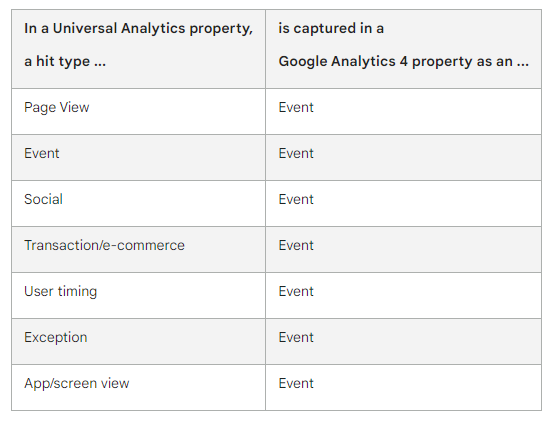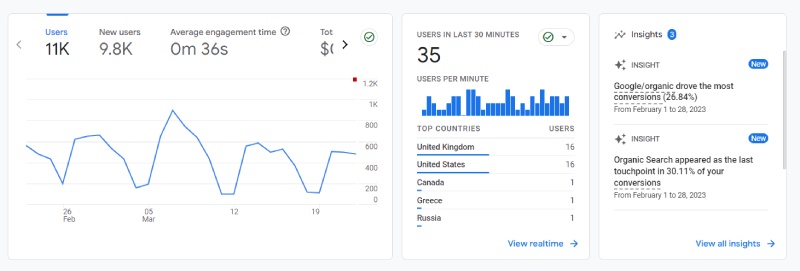On 1st July 2023, Universal Analytics will stop processing new data, and you will need to fully transition to GA4.
This gives you 2 months to get clued up on the GA4 and its key differences. Luckily for you, we have covered everything you need to know.
GA4 brings about significant changes to the way we think about and report on analytics. Keep reading for everything you need to know about the platform, including the key differences between the two platforms, the new metrics, and more.
Table of Contents
- What is GA4?
- Why is Universal Analytics going away?
- How does GA4 differ from Universal Analytics? Key differences
- How GA4 is changing analytics
- Final word
What is GA4?
GA4 is the latest version of Google's web analytics platform, built on a new event-based data model and built for cross device, cross channel, cross platform, and cross domain tracking.
It provides advanced features for analysing user behaviour, audience insights, and customer journeys across different devices and platforms.
But although it’s the natural replacement for its predecessor, Universal Analytics, it’s important to think of it as a completely different platform, one that operates very differently from UA.
Why is Universal Analytics going away?
Universal Analytics was built on session-based analytics, and designed with only desktop engagement in mind. This was fine at the time, but with the rise of mobile-first and the development of apps, it has become unfit for modern purpose.
Not only this, but Google’s move away from cookies – their key tracking method on UA – means they needed to rethink how they track engagement.
As a result, according to Google, GA4 is the next generation of a marketing, user-centric driven analytics tool and is built to be futureproof.
How does GA4 differ from Universal Analytics? Key differences
1. New data model: Sessions vs event-based data model
UA = Session-based
Universal Analytics uses a session-based data model, where a session is defined by a single visit to a website and focuses on understanding user behaviour in the context of a single visit. A session can comprise multiple page views, events, social interactions, and ecommerce transactions.
GA4 = Event-based
GA4 focuses on tracking individual events, which are specific actions taken by users on a website or app, rather than sessions. This allows for more granular tracking of user behaviour, as each event can be analysed separately.

2. How sessions are measured
Despite its new event-based model, sessions still exist in GA4, but are measured slightly differently.
In UA, a session represents the period of time that a user is actively engaged with your site. A SessionID is initiated by a user, the engagement and actions taken by the user are contained within the session.
The session requires cookies to be accepted for any data to be collected.
After landing on your site, the following ends a session:
-
30 minutes of inactivity
-
The clock passing midnight (resulting in a new session)
-
New campaign parameters are encountered (i.e. if you use UTM parameters for internal links on your website -- therefore, this is not recommended by Google).
In GA4, a session represents the period of time that a user fires a session_start event.
A StreamID is created when the 1st event is triggered (session_start) every event and engagement within the StreamID is associated to an “Active User”.
The StreamID will always be “listening” on the site even before or if cookies are accepted, if configured correctly.
How sessions in GA4 compare to sessions in UA:
-
As with UA, a session ends after 30 minutes of inactivity (or session timeout settings)
-
An event such as “scroll” “click” can extend and reduce sessions more often so the instances of recording a “Engagement Rate” are much higher.
-
Sessions do not end at midnight.
-
Sessions are not affected by encountering new campaign parameters.
-
Sessions can continue over different channels and devices (Attribution)
3. No more Views
GA4’s account structure is also different. In Universal Analytics, the structure of an account would be as follows:
-
Account -> Property -> View
For GA4, there are no longer views, and account structure is simply:
-
Account -> Property
In UA, Views were used to filter and segment data – for example to filter out internal traffic or show data for a specific language. However, with the proliferation of different types of devices and platforms, it became increasingly difficult to track and analyse user behaviour in a meaningful way using the View-based approach.
In GA4, data is organized into a hierarchy that includes the Property, which represents the website or app being tracked, and the Data Stream, which represents the source of data within that property. Event data within GA4 properties can be filtered and segmented to create customised reports.
The removal of Views in GA4 reflects a shift in focus towards more flexible and customizable data analysis, rather than the static reporting structures of previous versions of Google Analytics.
4. Machine learning insights
A key difference between UA and GA4 is that GA4 harnesses machine learning to provide better insights and analysis of website and app data.
For example, some events and engagement actions don’t fall under data or privacy protection laws and can be tracked by the StreamID and associated to the Active User. AI and machine learning in GA4 fills the gaps as to what an Active User does on the site and therefore it’s possible for Active User’s to have a tracked Ga4 Session, regardless of cookie acceptance. That doesn’t mean it will always be able to track users who reject cookies.
Machine learning is also used to identify high-value segments, optimize marketing campaigns, provide personalized recommendations, and create predictive models that can forecast future behaviour or outcomes, such as predicting the likelihood of a user returning to a website or making a purchase.
5. Dashboards & custom reports
GA4 features a streamlined, more intuitive reporting interface with drag-and-drop customization. Users can also create dashboards to present the important data easily and concisely.
This contrasts to UA which users have reported having a more complex and sometimes overwhelming reporting interface.

6. Event-based goals: Tag Manager more important than ever
With UA, it was possible to set up conversions either as an event or as a destination goal – with the latter triggering a conversion by a user landing on a defined page, for example a checkout page.
Now, GA4 only allows event-based goals – for example a click, form submission, video play, or download – requiring additional tracking code added in by a developer, or Google Tag Manager.
Whilst this makes setting up goals a little more complex, it will provide more granular insights into conversions, and we expect Tag Manager to be more important than ever in your analytics toolkit.
7. New metrics
As a new platform, based on a new data model, the metrics used to measure activity on GA4 have some key variations compared to Universal Analytics.
-
Sessions: In Universal Analytics, sessions are the main unit of measurement, representing a single visit to a website or app. In GA4, sessions still exist, but the emphasis is on events rather than sessions, and events can occur across multiple sessions.
-
Pageviews: In Universal Analytics, pageviews are a key metric used to measure website traffic. In GA4, pageviews still exist, simply called Views, but they are not the primary metric, and the focus is on events that capture user interactions.
-
Events: In GA4, events are the primary metric used to measure user behaviour. Events represent specific user interactions with a website or app, such as clicks, video plays, and form submissions. Universal Analytics also supports event tracking, but it is not as central to the data model.
-
User engagement: GA4 introduces new engagement metrics that measure user behaviour across sessions, such as engagement time, engaged sessions, and scrolls.
-
Conversions: In GA4, conversions are still a key metric used to measure the success of marketing campaigns, but the focus is on conversion events rather than goals. Conversion events represent specific actions users take, such as completing a purchase or filling out a form / clicking complete purchase or clicking submit form. Google have also recently enabled a new feature which allows users to specify how conversions are counted in GA4 – e.g. once per event or once per session.
-
Bounce rate: In Universal Analytics, Bounce Rate was calculated by dividing the number of bounces by the number of sessions. In GA4, Bounce Rate is now called Engagement Rate, and is defined as the number of engaged sessions (i.e. lasting longer than 10 seconds, has a conversion event, or at least 2 pageviews) divided by the total number of sessions over a specified time period.
-
Predictive metrics: GA4 introduces new predictive metrics, including churn probability and purchase probability, which can help marketers anticipate future customer behaviour and take proactive measures.
More information about the key metrics and UA comparisons can be found here.
8. Cross device and app tracking
Unlike UA, GA4 provides improved cross-device tracking capabilities, allowing marketers to track user behaviour across multiple devices and platforms.
Google uses a technology called "Measurement Protocol" that allows cross-device tracking. When a user interacts with a website or app that has GA4 implemented, a unique user ID is generated for that user. This user ID is associated with all their interactions with the website or app, regardless of the device they are using.
When the user switches to another device, the website or app will send the same user ID to GA4, allowing the user's actions on the new device to be linked to their previous actions on the original device. This allows GA4 to track the user's behaviour across multiple devices, giving a more complete picture of the user's journey and allowing for more accurate analysis and targeting.
How GA4 is changing analytics
In light of the changes, it’s important to rethink data collection – particularly related to hit types. Every hit is now an event, which means instead of relying on pageviews and sessions to understand website engagement, we can understand it on a much more intuitive level.
Not only this, but GA4’s move away from session-based measurement in favour of user-centric measurement means that users are now at the centre analytics.
Taking insights from granular events and machine learning, analytics is more holistic as a result, being able to track interactions with a website or app across multiple sessions and devices.
More information about how GA4 is changing marketing attribution can be found here.
Final word
Remember, on 1st July 2023, Universal Analytics will stop processing new data, and you will need to be fully migrated to GA4.
If you’re unsure about what you need to be ready for the change, contact us today.

